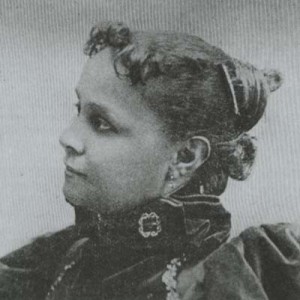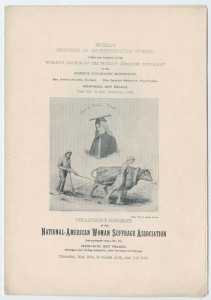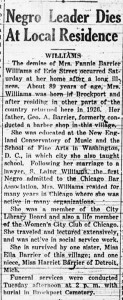 Born February 12, 1855
Born February 12, 1855
Birthplace Brockport, NY
Died March 4, 1944
Grave Site High Street Cemetery, Brockport, NY
Contribution Worked to secure equal rights and opportunities for all women, especially African-American women.
Quotation “I dare not cease to hope and aspire and believe in human love and justice …”
Frances (Fannie) Barrier would always look back on her youth in Brockport, New York as a time of innocence. At the same time, she also believed that these childhood experiences of “social equality” ill-prepared her for the racism that she faced later in life. Her growing awareness of the unfair treatment African American women received led her to pursue a lifetime of activism and strengthened her commitment to improving their lives.
The youngest of Anthony and Harriet Barrier’s three children, Fannie Barrier often recalled “old home and school associations” as “sweet and delightful.” Her father was a barber who later became a coal dealer, came to Brockport as a child from Pennsylvania, where he was born, and claimed to be of French descent. Her mother had been born in Chenango, New York and married Mr. Barrier in Brockport.
All three Barrier children went to and graduated from Brockport public schools. Fannie Barrier went on to the Brockport Normal School, a teacher college (now called SUNY Brockport), and was the first African-American to graduate from there in 1870. The children also attended church and Sunday School at the First Baptist Church in Brockport. Theirs was the only African–American family in the congregation, and each of them was very active. Fannie Barrier frequently sang or played the piano. Anthony Barrier was a clerk, trustee, treasurer, and deacon of the church and Harriet Barrier led a women’s Bible class.
After graduation, Fannie Barrier went to teach in the Washington D.C. area, hoping to help the freedmen. Life there was very different from what she had experienced and she was “shattered” by the discrimination she encountered. She enrolled in the School of Fine Arts in Washington to study portrait painting, and found herself surrounded by screens that separated her from the other students. In response to her complaints, she was informed that that was the only way she could remain in the class. She had a similar experience at the New England Conservatory of Music in Boston where she wanted to further her piano studies, but was asked to leave after all the students from the southern states threatened to quit if she stayed.
She returned to her teaching, and met S. Laing Williams, her future husband, in Washington, D.C. He was a native of Georgia and worked in the United States Pension Office. He was also a law student at Columbian University (later George Washington University Law School). They were married in her Brockport home in August 1887, returned to Washington, and then moved to Chicago, Illinois. S. Laing Williams was admitted to the Illinois bar and began a successful law practice.
No longer teaching, Fannie Barrier Williams became very active among the Chicago reformers. She was director of the art and music department of the Prudence Crandall Study Club, an exclusive organization formed by Chicago’s elite African-American community. Barrier Williams was able to extend her view well beyond this privileged group to the needs of all women. With her husband, she worked for the Hyde Park Colored Voters Republican Club and the Taft Colored League. An associate of both Frederick Douglass and Booker T. Washington, she represented the viewpoint of African-Americans in the Illinois Women’s Alliance and lectured frequently on the need for all women, but especially black women, to have the vote.
Recognizing the lack of services available to women, Barrier Williams helped to found the National League of Colored Women in 1893 and its successor, the National Association of Colored Women (NACW) in 1896. These organizations provided kindergartens, mothers’ groups, sewing classes, childcare centers, employment bureaus, and savings banks for women who would not have had access to them elsewhere. Similarly, when she became aware of the lack of African-American physicians and nurses in the hospitals, she helped to create Provident Hospital in 1891, an inter-racial medical facility that included a training school for nurses that admitted African-American women. She was also instrumental in the creation of the Frederick Douglass Center in 1905, a settlement house, and the Phillis Wheatley Home for Girls. The latter became part of a national movement, and the hospital and settlement house still serve the Chicago community today. She was also the first African-American and the first woman on the Chicago Library Board.
 Barrier Williams achieved considerable recognition when she waged a battle for the representation of African-Americans at the Columbian Exposition of 1893 in Chicago. She succeeded in having two staff appointments designated for African-Americans and having African-American interests included in the program. She herself was appointed as Clerk in charge of Colored Interests in the Department of Publicity and Promotions. She was also invited to present two major addresses, one to the World’s Congress of Representative Women and the other to the World’s Parliament of Religions. In the first, The Intellectual Progress of the Colored Women of the United States Since the Emancipation Proclamation, Barrier Williams disputed the notion that slavery had rendered African-American women incapable of the same moral and intellectual levels as other women and called on all women to unite to claim their inalienable rights. This was followed by a discussion and words of praise from Frederick Douglass.
Barrier Williams achieved considerable recognition when she waged a battle for the representation of African-Americans at the Columbian Exposition of 1893 in Chicago. She succeeded in having two staff appointments designated for African-Americans and having African-American interests included in the program. She herself was appointed as Clerk in charge of Colored Interests in the Department of Publicity and Promotions. She was also invited to present two major addresses, one to the World’s Congress of Representative Women and the other to the World’s Parliament of Religions. In the first, The Intellectual Progress of the Colored Women of the United States Since the Emancipation Proclamation, Barrier Williams disputed the notion that slavery had rendered African-American women incapable of the same moral and intellectual levels as other women and called on all women to unite to claim their inalienable rights. This was followed by a discussion and words of praise from Frederick Douglass.
The second speech, “What Can Religion Further Do to Advance the condition of the American Negro?” called upon churches, particularly those in the South, to open their doors to all people, regardless of race. She also proclaimed a continuing belief in the ability of religion and faith to correct society’s problems. Perhaps it was this belief that gave Barrier Williams the courage to challenge every day injustices. When she was nominated to the prestigious Chicago Women’s Club in 1894, she and her friends received various threats. Barrier Williams continued to fight for inclusion, not because the club mattered to her so much, but because she believed that she owed it to her friends who supported her not to quit, and to all African-American women to show perseverance. She was admitted in 1895, the same year she established the National Federation of Afro-American Women with Mary Church Terrell. This group also became a part of the National Association of Colored Women. At the National Colored Women’s Congress in 1895, these women, along with Ida Wells Barnett, had broken with Booker T. Washington, and allied with W.E.B. Dubois. They believed Washington compromised with the “white supremacist” South too much. In addition to condemning discrimination and lynching, these women passed a resolution calling for a fully integrated women’s movement.
Barrier Williams retained her friendship with Dubois and was among the founders of the National Association for the Advancement of Colored People (NAACP). Her work to secure women’s rights was recognized when she was the only African-American selected to eulogize Susan B. Anthony at the 1907 National American Women’s Suffrage Association convention. She continued to fight for women’s rights, and to implement programs and associations that could improve their lives. She remained in Chicago, even after the death of her husband in 1921, and then returned to Brockport in 1926 to live with her sister. She continued to advocate for African-American women, if only from the sidelines, until her death in 1944.
Bibliography of Suggested Books & Articles
- Archer, Jules, Breaking Barriers: The Feminist Revolution from Susan B. Anthony to Margaret Sanger to Betty Friedan, New York, NY: Viking, 1991.
- Dannett, Sylvia G.L., Profiles of Negro Womanhood, Yonkers, NY: Educational Heritage, 1964-66, v.1, p.327.
- Garraty, John A. and Mark C. Carnes, American National Biography, New York: Oxford University Press, 1999, vol. 23, pp.455-56. (Biography written by Mamie E. Locke.)
- Hine, Darlene Clark, Black Women in American History, Brooklyn, NY: Carlson Pub., 1990.
- Jackson, George F., Black Women: Makers of History, Sacramento, CA: Dome Print. & Pub., 1975, pp. 30-31.
- Williams, Fannie, “A Northern Negro’s Autobiography,” The Independent, vol. LVII, No. 2002, July 14, 1904.